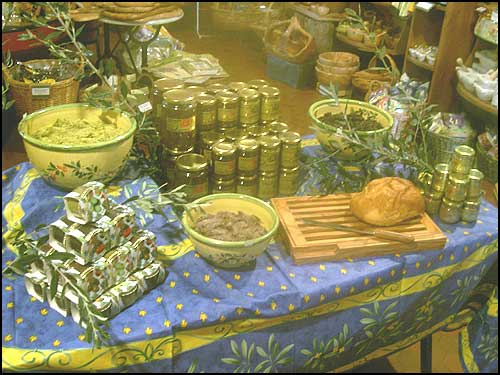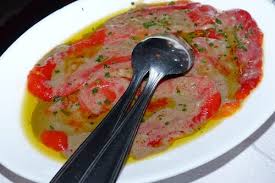Vaison-La-Romaine
Located in the northern part of Provence (30 miles
northeast of Avignon), Vaison makes my list because its a two-for-one: significant Roman ruins plus a fabulous
market. As its name implies, Vaison was
a famous “Roman” town. Rich ruins of the
Roman occupation dating before the birth of Christ marry with a charming
medieval town to create a picture-perfect backdrop for the market.
 |
| Olive-centric gift shop in Nyons showcases products made from or about olives |
Nyons
Not far from Vaison, is another market I really
enjoy. Nyons is the epicenter for
Provence’s famous olive production. In
fact, these olives are so renowned that they have their own appellation (A.O.C). While all Provençal markets feature the ubiquitous local olives, Nyons takes olives to
an entire different level: there are stalls
specializing in EVOO cosmetics featuring a cornucopia of lipsticks, body
creams, shampoos & conditioners, and soaps in every color of the
rainbow. Other sellers tantalize you
with food products ranging from tapenade to an unforgettable multi-layer hot potato
gratin oozing with cheese, carmelized onions, local olives and lardons
(France’s bacon)---all cooked in a super-sized paella pan in a wood-fired oven.
Tantalizing Provencal fabric abounds in the form of tablecloths, napkins, runners & placemats
Isle
sur Sorgue
This town, called the "Venice of Provence," is enchanting. Built along the winding waterways of the Sorgue river, Isle sur Sorgue is a cluster of small “islands” all connected to one another with tiny foot bridges. Always on Sunday, this market is packed with weekenders who come for the city’s outdoor antique market and uber fresh local produce. Word of warning: go early (before 9). The last time I visited it took nearly 30 minutes to find a parking place, and another 30 minutes to walk from the outskirts into the center.
Valbonne
In some ways I’ve saved the best for last. In spite of the fact that this is the smallest market of the four, in many ways it’s the most magical. Located 10 miles from the Riviera's jet-set Cannes, Valbonne is a pedestrian-only town of 13,000. The entire village is a medieval jewel box so it’s no wonder why it often used as a movie set (e.g. French Kiss with Meg Ryan). Valbonne’s weekly market, held on the charming central square, also spills over onto the cobblestoned side streets and arcaded alleyways leading away from center. Once you finish with the market, head to these charming backstreets where you'll see another side of the French Riviera.


.jpg)











